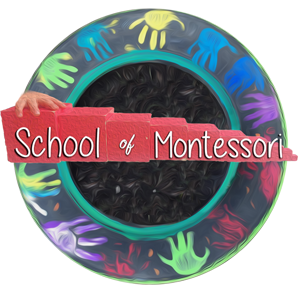The child learns concepts in circumference by matching the lids to jars, lessons in open/close with zippers, buttons, and velcro. Concentration develops as the child sorts various items that have different functions for their use. This lesson prepares children for dressing frames, opening lunch containers with independence, and getting dressed. i.e. putting on a coat, and zipping without help from adult.
Materials
- Jars of various sizes, mason jars and recycled food jars will work
- Matching lids for Jars
- Small woven basket which the materials will fit in
Activity Area
- Shelf to table.
Language
Big-Little/Small-Large
Thick-Thinner-Thickest/Thin-Thinner-Thinnest/Broad-Narrow
Short and Wide/Tall and Narrow
Tall-Taller-Tallest/Short-Shorter-Shortest
Holes: Deep-Shallow/Wide-Narrow
BLOCK ONE
Each cylinder decreases in height and diameter.
The Yellow Knobless Cylinders have the same dimensions.
BLOCK TWO
Cylinders decrease in diameter while remaining constant in height.
The Red Knobless Cylinders have the same dimensions.
BLOCK THREE
Cylinders increase in height and decrease in diameter.
The Green Knobless Cylinders have the same dimensions.
BLOCK FOUR
Cylinders decrease in height while the diameter remains constant.
The Blue Knobless Cylinders have the same dimensions.
Points of Interest
- Taking the cylinders out, one at a time, with three finger grip.
- Seeing and feeling the different sizes and shapes of the graded cylinders.
- Seeing that each cylinder fits into its own socket perfectly and smoothly
- Putting cylinders down quietly on the table and in the socket.
- Seeing and feeling shallow and deep sockets.
- Using counter clockwise motion for tracing.
- Using left to right sequence.
- Seeing knobs face up.
Control of Error
- Seeing and feeling that cylinders wiggles inside the socket.
- Seeing that the last cylinder doesn’t fit.
- Seeing and feeling an uneven surface.
- Cylinders falling on the floor because they are not being handled carefully.
- Noise of cylinder striking the table or block striking the table.
Direct Aims
- The development of visual and tactile perception of discrimination of size and gradation in a series.
- Awareness of discrimination in one’s environment with an intelligent eye.
- Development of eye-hand coordination of refining motor movement.
Indirect Aims
- Preparation for writing through the use of the three finger grip.
- Preparation for geometry with cylinders and circles.
- Preparation for mathematics.
Aditional Exercises
- Allow the child as much creativity as possible, as long as she upholds the principles of building LONG to SHORT, or SHORT to LONG.
- Stack the rods one on top of another, tower style, leaving equal amounts of space on either side of all rods. Place longest one first.
- Child may put the cylinders in graded order after placing them in random order on the table, before putting them in their sockets.
- Child may work with the second, third or fourth block.
- Child may work with more than a block at a time.
- Child can try to do all four blocks at once, blindfolded.
- Put the cylinders in sockets upside-down,
- Rotate the cylinders in the sockets and then rest them at an angle on top of the socket, not inserting them.
- Turn the block on its side and pulling out the cylinders.
- Place the block on an end, take out the cylinders and put them back. Be careful not to push the block over.
- Placing the cylinders in alternate order
- One standing up, the next one laying down and so on.
- Memory Game: Take the cylinders out and place them on another table, ask the child to go from memory to table to find the correct cylinder for a specific socket.
Extensions
- Templates for Knobbed Cylinder block placement.
- Blindfolded
Notes
- Later, a mat on the table or a rug on the floor may be introduced with this material. In the beginning, a table top is important in learning to handle the cylinders with care.
- Do not present the other Knob Cylinders, the child should discover them and their differences by themselves.
- When working with two or more blocks, cylinders are taken out and placed in the center of the blocks.
About Instructor
